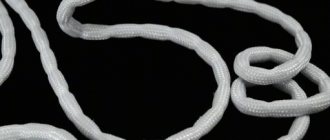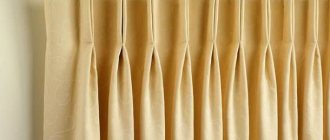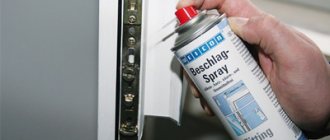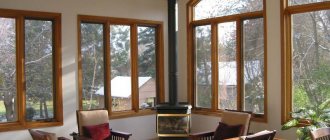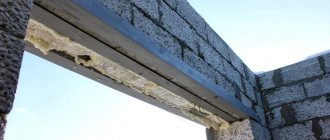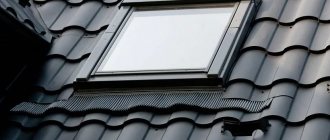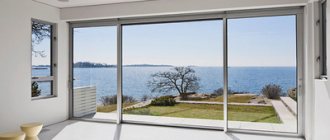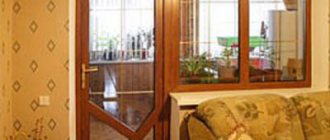Types of mounting tapes for windows
The functions performed by the tapes are different and depend on the location of gluing, the condition of the opening, the features of the future finishing of the slopes, as well as the requirements for the window block. Next, we will consider the most commonly used materials common in the modern construction market.
PSUL
Pre-compressed sealing tape is used primarily on the outside of translucent structures. Its main purpose is to ensure unimpeded drainage of moisture from the area where the hatch connects to the opening.
Essentially, this is a tape product made of elastic polyurethane foam (looks like foam rubber), usually gray or black. One side of the material is covered with an adhesive composition, insulated with a protective film. The tape is supplied twisted into compact reels or rolls (depending on the size), which need to be unwound only during the installation process, since the material loses its quality over time.
An example of tape expansion over time
The main feature is the ability to fill joints as a result of expansion, which occurs as a result of contact with air. The tape isolates the gap from moisture and external influences from the outside, while simultaneously allowing excess liquid to evaporate from the inside.
Scope of application of PSUL:
- Additional sealing of interfaces between elements of prefabricated structures;
- Sealing the gap between the frame and the opening when installing windows and doors;
- Insulation of joints between small-sized moving units of building facades;
- Filling the external seam between the slope and the frame during the installation of PVC windows.
It is important to understand that to fill the gap efficiently, you need a tape of the appropriate size. For example, if the task is to seal a joint with a maximum width of 40 mm, you will need a PSUL with a nominal size of 45-50 mm.
Water vapor barrier (GPL)
This type of tape product is most popular when installing window blocks. Among its main features it is worth highlighting the following:
- Water vapor barrier mounting tape is designed to seal joints on the room side.
- Polyethylene film is most often used as the basis for self-adhesive material. On one side the tape is equipped with a foil coating, and on the other - with an adhesive composition.
- The adhesive used provides reliable fixation on most surfaces (concrete, brick, cinder block, wood and others). The products of some brands have poor adhesion to foam blocks and aerated concrete, so before purchasing you should consult with the seller or read the attached instructions.
- The structure of the material prevents the penetration of moisture or air both through the tape itself and through the gluing points. This ensures the maximum possible tightness of the joint of the opening and, as a result, the structure as a whole.
- In addition to insulating from moisture, the tape does not deteriorate during prolonged contact with ultraviolet radiation and is not subject to destruction from exposure to aggressive environments (household acids, alkalis and other reagents).
Brands of connecting tape
In order to choose the appropriate option, it is not enough to know only the technical characteristics or material of the adhesive tape. When you come to the store, you already need to know the brand of adhesive tape and tell it to the manager. Below we will look at some popular options; based on this information, you can decide exactly what is suitable for your needs.
Izospan SL
This tape is used simultaneously to seal the joints of hydro and vapor barriers. It was developed to seal the junctions of protective films to structures passing through the roofing pie of the attic floor. For example, it is used near chimneys, pipes and ventilation ducts or roof windows.
In addition, its working surface adheres perfectly to the walls and provides a reliable, hermetically sealed connection. Therefore, Izospan SL tape is used to treat the edges of the vapor barrier layer in the attic.
As for the technical characteristics, the most important information concerns the adhesion strength. If we talk about the connection with concrete, then the tensile strength is 0.1 MPa. But gluing to metal surfaces is not recommended, as adhesion is reduced tenfold.
The water absorption of the adhesive tape is equal to 0.2%, this is an excellent result when compared with roofing roofing felt, whose figure fluctuates within 2%. The operating temperature is between -60 and + 140 °C. This tape is suitable for use in any area.
Izospan SL belongs to the group of double-sided adhesive tapes, so it is only suitable for installing overlapping vapor barriers. To do this, tape is glued to the edge of the first roll, then the release paper is removed and the second roll is applied.
TechnoNIKOL
This tape has working surfaces on both sides. The basis for the tape is polypropylene, but despite this, the material performs its functions perfectly. The length of one roll is 25 meters and the width is 3.8 cm. Thanks to the low cost, about $3 per piece, you can save on insulation without losing quality.
TechnoNIKOL adhesive tape is intended only for gluing vapor barrier rolls. It cannot be used when sealing film junctions with load-bearing structures. Most often it is used in residential private construction and industrial buildings.
Ondutis ML and BL
The mounting tape is designed for a service life of up to 15 years. Depending on the marking, the scope of application and the surfaces to which the tape can be glued differ. So, ML is a tape with an adhesive composition on both sides of the fabric base. The connecting compound is synthetic rubber, which is durable and reliable. Available in rolls 50 mm wide and 25 meters long. Designed for gluing vapor barrier in roofing pies and walls.
Ondutis BL also has two adhesive sides, one of which is covered with non-sticky paper. Used to seal joints between vapor barriers and hard surfaces. It is used to process connections with brick, concrete and wooden walls. In addition, it can be used as a fastening film to concrete walls.
Nicoband
A more expensive version of vapor barrier tape that has an aluminum base and two adhesive surfaces. The tape has several color options and is produced in rolls 10 meters long and 100 mm thick. The cost of this option is $11, which is explained by the scope of application.
Nicoband mounting tape is used to seal external seams. It is capable of firmly bonding insulating film to plaster, wood, metal, roofing and concrete. The manufacturer guarantees a tight connection for 10 years.
Installation features
The tape is applied both before fixing the window block in the opening, and on already installed structures. The first option is more convenient in cases with the installation of external insulation.
Let's consider the algorithm for using tape insulation using the example of gluing pre-compressed sealing tape (PSUL) and internal GPL-S with an additional strip of double-sided tape:
- We prepare the opening. If there is an old window unit, we dismantle it as carefully as possible, without causing unnecessary damage. After dismantling, we level the surfaces adjacent to the future structure and clean them of foreign contaminants.
- We perform a test installation of the block in the opening, temporarily fixing it. This is necessary to mark the edge of contact between the walls and the window, so that when gluing the tape is hidden behind the outer slopes.
- We measure the window block. In accordance with the obtained dimensions, we cut PSUL for gluing on the top and sides of the frame; we prepare diffuse tape to isolate the area where the molding profile is attached.
- We do the same with GPL-S (internal slopes) and butyl rubber tape (for the window sill profile). The material is measured for each side with an allowance of 10 cm to form corner joints.
- We apply the tape, gradually removing the protective layer from the adhesive surface of the PSUL. We glue GPL-S to the inside of the window profile using a strip of double-sided tape (we do not remove the protective film from the main adhesive surface at this stage).
- We fix the window in the opening. We wedge it, and then fasten it with anchors or using mounting plates. We fill the seams with polyurethane foam.
- After complete polymerization of the foam and rough preparation of the inner surface of the walls, we fix GPL-S on them (remove the protective paper and glue it to the slopes).
It should be remembered that the tape must be selected in accordance with weather conditions. When working in winter, it is possible to glue only material intended for use in low temperature conditions.
Dimensions and approximate cost
Diffuse insulating tape for installation outside (under low tide):
- Width -70 mm;
- Length in a skein – 25 m;
- The price of a skein is 436 rubles.
PSUL for use at sub-zero temperatures:
- Width – 20 mm;
- Thickness – 8 mm (40 when uncompressed);
- Length – 5 m;
- Price – 160 rub.
Internal duplicated tape:
- Width – 100 mm;
- Length per skein 25 m;
- The price of a skein is 377 rubles.
Inner metallized tape:
- Width – 45 mm;
- Length – 24 m;
- Price for 24 m – 523 rub.
Tape for window sill profile:
- Width – 200 mm;
- Length – 12 m;
- Price – 600 rub.
Subtleties of choice: manufacturers and prices
When choosing a self-adhesive tape, you should pay attention to the profile and material from which the insulation is made. For cracks with a width of 1-3 mm, profile C or E is suitable, for 3-5 mm - P and V, for 3-7 mm - B and O.
Important: shelf life plays a big role in insulation materials, since the glue dries out over time.
The modern range of insulation products includes many manufacturers:
- rubber insulation, which can be found in any store - from 160 rubles for 5 meters;
- Ultima - Polish foam rubber seals, price from 220 rubles per 12 m;
Penosil - two-component insulation made of EPDM rubber, price from 600 rubles;
- "Penofol" - foil-coated polyethylene foam, price from 108 rubles per m 2.
But you can find out how and where you can use liquid insulation in Polinor cylinders by reading the contents of this article.
It will also be interesting to learn about what kind of insulation to put under linoleum and how to do it correctly.
But what is the price of insulation for a warm water floor and which one should be used, this information will help you understand.
Which floor insulation under screed is the best to use and how to use it correctly, you can read in this article.
But what is the price of foil insulation for the floor and where should such a building material be used, this information will help you understand.
Mandatory three layers: vapor barrier for PVC windows
Photo from the site: isollab.ru
Whatever one may say, proper vapor barrier from the inside, as well as waterproofing from the outside, really plays a huge role in preserving the walls and window structures themselves, preventing cold air from getting inside, as well as warm air leaking out. Moreover, the places of the installation seam are the most vulnerable, which is why they must be made taking into account all the technological nuances, one of which is the vapor barrier of window slopes, seams, openings, and so on. Moreover, professional builders distinguish three main layers, the quality of which must be monitored.
Worth knowing
Correct installation of window structures that provide three levels of insulation, that is, when the seam is three-layered, which can be read below, can completely prevent it from freezing through during the winter cold. This also completely eliminates the appearance of condensation on the slopes, preventing their cracking and damage. That is, you can choose a wide variety of materials for yourself, fortunately the market provides such an opportunity, but in any case there should be three layers of sealing.
- The middle seam, which is located just under the window structure, performs the function of heat and sound insulation, and it can safely be considered the main one, as if load-bearing.
- The layer on the outside is considered waterproofing, since it prevents moisture from getting inside, which can cause the entire structure to “sink,” terrible black mold may appear, and so on.
- The inner layer is a vapor barrier, which prevents heat from escaping from inside the premises.
In fact, everything is quite simple and all of the above means that the first layer from the inside must have vapor barrier properties, there is a porous layer inside to protect against frost, in the manner of polyurethane foam, and also a waterproofing agent on the outside so that water cannot penetrate inside. Moreover, many manufacturers produce a complete set of materials, including vapor-waterproofing tape for windows, which will be just the best solution, so it’s worth listening to the professionals, because they know exactly how everything should be. Some, naturally, want to reduce the cost of installing windows, which already cost a lot of money, and refuse steam and waterproofing, but this is completely unacceptable.
About insulation
The microclimate of the room depends on the windows. Due to uninsulated windows, the glass fogs up, cracks and fungus appear on the slopes, and there is always a draft and street noise. To effectively insulate windows, it is necessary to determine the reasons for low thermal insulation.
Most often they are the following:
Wooden windows
First of all, insulation is required for old window structures for the following reasons:
- Previously, glass was secured to the frame with special putty. Over time, it dries out and becomes stained;
- the frames dry out, so cracks and gaps appear between the glazing bead and the glass;
- the sashes are deformed and are not held tightly to the frame.
Plastic windows
It is mistakenly believed that such windows are quite airtight and therefore do not need insulation. Unfortunately, after a few years the seal collapses, and insulation is indispensable.
There are other reasons why it is necessary to deal with plastic windows:
- violation of window installation technology;
- distortion of the window structure due to shrinkage of the house;
- factory defect of window design;
- mechanical damage to structural elements.
Vapor barrier tape for PVC windows: general information
Photo from the site: isollab.ru
It is clear that if you really want to ensure the reliability and durability of a brand new PVC window so that it lasts the longest possible time at the lowest cost, you should always do everything thoroughly and according to technology. High-quality materials for sealing, high professionalism of the installers themselves, good quality of the window frame and double-glazed windows, as well as a good vapor barrier tape for windows can guarantee high performance in all necessary parameters. Moreover, it is worth knowing that the higher the humidity inside the premises, the better the quality of the vapor barrier should be, preventing moisture from getting on the slopes, frames, and so on.
First of all, you need to know that all vapor barrier tapes can be divided into those that have only one adhesive surface, with which they will be attached to the frame itself, and those that are double-sided. The second option can already be fixed not only on the window structure itself, but also in the opening. Among other things, before a PVC window vapor barrier is purchased and installed, you need to find out what weather and climatic conditions it is intended for. Moreover, there is a summer version of films on sale, designed for temperatures from five to thirty-five degrees Celsius, as well as from zero and below, that is, a winter version.
Other publications in the “Windows” section. Translucent structures”
Everyone has long known that life outside the city is very different from life in the city. But living conditions should be good in any place, be it a city or a village. And since this is a country house, you need to take care of the windows, as they will create good thermal insulation. After all, it’s in the cold.
Question: When installing plastic laminated windows, the installers carelessly foamed them: they stained the laminated surface in many places, and the foam crawled onto the frames. A few days later, after filing a claim, the installers came to fix their problems. The foam was washed off with a special solution.
Question: After 5 years, dark streaks and spots appeared on the k-glazing unit, why? Answer: I think that you have not k-glass in double-glazed windows, but i-glass. Based on the presence of the defects you described, this corresponds to i-glass that has oxidized in air due to the loss of tightness of the double-glazed window (see.
Source: blogstroiki.ru
The best mounting tape for windows: what it can be
It is also worth knowing that adhesive tape for vapor barriers can be made from butyl rubber, and this particular option is intended for insulating balconies, windows, as well as door blocks and interpanel connections. Inside such a tape there is always a reinforcing layer of non-woven fabric.
Photo from the site: gidroizolyaciya-pro.ru
The second option is metallized tape, specially designed for insulating seams and joints in rooms with high humidity. It also has an adhesive layer, which greatly simplifies the installation of the structure, as well as the subsequent finishing of slopes, and so on. In addition, the width of the tapes of this plan may also vary, depending on the manufacturer. You need to choose one that is several tens of millimeters wider than the mounting seam itself.
Full-butyl vapor barrier tape made using the Robiband system has all the prerequisites to ensure high-quality ventilation of the assembly joint. Moreover, this system fully complies with all, without exception, standards and requirements that apply to it.
Photo from the site: gidroizolyaciya-pro.ru
- The first on the list is a material such as PSUL tape, which can really ensure a reliable fit of the door or window frame to the wall. Full-butyl vapor barrier tape PSUL is intended for external vapor barrier. It will help to qualitatively seal all joints and seams.
- BC insulating tape is intended for sealing seams in cases where dry finishing is intended. For example, under drywall, sandwich panels, plastic, and so on. It has a layer of adhesive coating along the width of the tape, which greatly simplifies installation and can also prevent condensation from falling onto slopes from inside the room. Similarly, the option with BC+ tape is also designed for interior work, for dry finishing. It is also glued over the entire surface, protected by an anti-adhesive film.
- Robiband vapor barrier tape VM is another extremely good quality option. It is also used for interior work, and wet plaster can already be applied on top of it. A more advanced version of this tape is VM+.
- The tape is hydro-vapor barrier, that is, GPL is made of high-quality foamed polyethylene, laminated on one side, and also equipped with a metallized layer, as well as with an adhesive surface across the entire width of the tape itself. This tape is completely universal and can be used in almost all cases. There are also variations on the theme, for example, GPL-S tape.
Important
It is imperative to understand that vapor barrier tape with a protective strip of polypropylene resists quite well all kinds of mechanical damage. Among other things, it has enviable resistance to aggressive environments, that is, it is not afraid of acids, alkalis, or organic solvents.
We understand the variety of types of tapes - VS or GPL?
The first on the list is PSUL (pre-compressed self-expanding tape for compaction). It ensures a good fit of the window frame or door frame to the wall. This tape is used for vapor barrier of external joints and seams.
The next material is vapor barrier BC. It is used to seal seams when dry lining is being carried out. For example, under sip panels, gypsum boards, plastic surfaces and more. The tape has an adhesive layer across its entire width - this property greatly facilitates the installation process. There is an improved option - BC+. It is filled with an anti-adhesive film. This additional coating ensures strong adhesion of the insulation to the building materials.
Robiband tape VM for vapor barrier
Robiband tape VM for vapor barrier is the next good material option for processing seams. It is used for indoor work, and a wet plaster solution is applied on top. Vapor barrier VM+ is a sophisticated option with excellent performance characteristics.
The last type is GPL (hydro-vapor barrier material). It is made from good quality foamed polyethylene. The tape has one laminated side and an additional metallized layer. Its second surface is completely covered with glue. This tape is multi-purpose, in other words it can be used for all types of work. Its variety is GPL-S tape, which has similar characteristics.
Properties and scope
The material has the following properties:
We recommend: How to level a wooden floor: leveling an old wooden floor with your own hands
Characteristics:
Application area:
The main purpose of the self-expanding tape is to protect the mounting foam from destruction, which can occur from sunlight and water.
When installing plastic PSUL windows, a three-layer insulation system is used. The first (outer) layer, when the opening is a quarter of a brick. Next, the space is butted and the sealant is filled into all the voids. This thereby protects the assembly seam from natural phenomena and ensures ventilation from the outside.
1
Is it worth spending money on protecting window seams?
When installing a window in an opening, remember that its service life is related to how competent the installation is. Even the highest quality structures will not be used for a long time if the installation is carried out incorrectly. Due to improper work, moisture will gradually penetrate the walls, leading to the destruction of building materials and the spread of mold.
Vapor barrier tape
When installing the frame, consider several important points:
On the inside of the room we make a denser layer of installation solution (for example, foam). To properly seal all gaps, we use three-layer protection - the outer material protects from the effects of precipitation, the middle layer is responsible for thermal insulation, and the coating of the inner surface is for vapor barrier.
Vapor barrier provides reliable protection of the thermal insulation layer from condensation, which is present not only in the bathroom, but also in an ordinary room. In the process of finishing the window slopes, we glue a special tape. The principle of vapor barrier is based on blocking the contact of moisture with polyurethane foam, which forms the middle protective layer. Materials with low elasticity and permeability to water and air are suitable for these purposes. When installing windows, you cannot save on vapor barriers. Such neglect will lead to rapid wear of frames, plaster and finishing materials.
To protect the seam, special vapor barrier tapes are usually used. They come in a coiled and compressed sponge-like material. Absorbing moisture, the material swells, sealing all existing cracks. Vapor barrier tape for plastic windows has a number of advantages:
1. isolates moisture; 2. is consumed economically, with virtually no waste;3. does not emit toxic substances;4. easy to stick;5. has a long service life.
We recommend
The height of the window from the floor is standard. Cover the cabinet with self-adhesive film. LED strip under the suspended ceiling.
How to apply insulation tape to windows. How to insulate old wooden windows for the winter
This short article will tell you how you can quickly and without significant costs insulate old wooden windows for the winter.
Personally, I encountered the problem of window insulation when I rented an apartment. In summer and early autumn the apartment was comfortable, but when severe frosts began, the old wooden windows began to feel cold. The main source of cold was the cracks at the bottom of the window - between the frame and the window sill.
The method that will be discussed below will help to cope with the problem temporarily, which is, in principle, suitable when the apartment is not yours or you are just planning renovations.
To insulate windows, we need a special material - thermal tape.
This is a very common and inexpensive material. The average retail price of a roll (length - 10 m, width 50 mm) is approximately 30 rubles. One roll is enough to insulate a standard kitchen window in a Khrushchev-era apartment building. That is, for a two-room apartment you will need 3-4 rolls, which in total will be 90-120 rubles.
The thermal tape is self-adhesive, that is, an adhesive composition is already applied to its surface, which is a big plus. It is also worth noting that the glued heat tape holds securely, but if necessary, it can be easily removed without damaging the paintwork or leaving marks. This material, useful for the home, is made of polyethylene foam, which has excellent thermal insulation properties.
It is recommended to carry out window insulation work at temperatures above +10°C, this will ensure reliable adhesion of the adhesive composition of the material to the surface of the window frame, slopes and window sill.
We take a roll of thermal tape and glue the window around the perimeter, as well as between the sashes.
Smooth the glued area with your hand, cut off the excess with a construction knife or scissors. The entire process of insulating windows is very simple and takes a minimum of your time. Comfort and warmth to your home!
Vapor barrier tape for windows: use and installation + video
This is a tape made of aluminum or butyl rubber, which is glued to damp foam on the internal slope on the room side for moisture and vapor barrier.
The purpose of the installation is to protect the installation seam from moisture, which could destroy it. Installation is required in accordance with GOST requirements.
GOST requirements for assembly seams
According to GOST, a vapor barrier tape must be glued to the RAW foam from the inside of the room. On one side it is glued to the plastic profile, and on the other to the slope.
Installation
The tape is glued to the frame BEFORE applying the foam. That is, you glue it to the frame, then apply foam to the seam, and immediately secure it to the opening.
To see it more clearly, watch the video:
Basic methods of insulating window frames
There are various means for insulating windows, the distinctive characteristic of which is not only the price, but the following indicators:
- durability;
- fastening feature;
- ability to retain heat and resist cold.
Do-it-yourself window insulation
Let's consider several different options, with a detailed description of each type of insulation. Detailed instructions will also be given on how to secure this or that type of material with your own hands. This will allow you to choose the best option for you.
Cotton wool and tape
There is a special tape for insulating windows, which is simply glued to the frame, covering the cracks.
If you can't buy it, you can use:
- regular tape;
- cotton wool
This method is quite economical. To implement it, you need to caulk the cracks with cotton wool, using a thin, sharp object with which you can tightly push the cotton wool, and seal it on top with ordinary tape.
As mentioned above, this is an economical method, but this is, in fact, the only positive characteristic.
There are also several negative aspects.
- fragility
- low aesthetics;
- poor efficiency, especially in severe frosts.
Based on foam rubber
The second most popular is foam rubber for insulating windows, the price of which is also not high, but it:
- easy to stick;
- quite effective;
- It is equally suitable for both wooden and plastic windows.
Using foam rubber
This adhesive-based material is relatively aesthetically pleasing and is guaranteed to last for one season.
Modern and airtight
Recently, insulating windows with silicone sealant has become increasingly popular.
It is especially effective if you have:
- wooden frames;
- large or even huge gaps in frames.
Application of silicone sealant
Silicone-based sealant is relatively inexpensive.
It must be applied exactly to the gap:
- between the frame and the box;
- between frame and glass;
- between the box and the wall.
The main, undoubted advantage of this material is its high tightness. It really protects from the wind, but there is a problem - if it is applied into the gap between the frame and the box, it will be extremely difficult to clean the surface of this material.
High quality putty
Another good sealant for insulating windows is window putty. This method of insulation was used a couple of decades ago. The putty is similar to hard, rigid plasticine, but if you squish it a little in your hands, it becomes more pliable, making it easy to apply into crevices.
The putty is applied as follows:
- Having softened it, apply it to the cracks;
- if they are too big, try pushing the putty inside a little;
- After hardening, the putty will become not only strong, but also dense.
Applying putty
This material has many positive characteristics:
- quite economical;
- one block, the price of which is low, is enough for one large frame;
- does not absorb and even repels moisture.
The only visible drawback is that it takes a relatively long time to apply the insulation.
Rubber based insulation
The modern method of insulation is a special rubberized insulation.
According to consumer reviews, this method:
- reliable;
- effective;
- durable.
Naturally, its price is slightly higher than other materials, but it is worth it.
Insulation is divided into several main categories, each of which has a specific letter index:
- category “E” - thickness from two to three and a half millimeters and is optimal for insulating plastic windows for the winter;
- category “D” is a denser material, the thickness of which ranges from three and a half to eight millimeters, and therefore it is ideal for wooden frames and boxes;
- category “P” - thickness reaches from three to five and a half millimeters, it is optimal for both wooden and plastic frames.
The material does not absorb moisture, and is also effective even in severe, severe frosts, when the air temperature drops to minus forty.
Innovative material
Today, film for window insulation is also quite in demand.
It is attached directly to the glass, which allows you to:
- let in light from the street;
- reflect infrared rays;
- keep the room warm.
Film installation
When installing it, you should be careful, and it is applied directly to a clean surface with clean hands or gloves. The only thing that needs to be noted is that heat-saving film for window structures allows you to retain the heat that “comes out” through the cold glass, but does not close the cracks.
What should the vapor barrier be like?
Vapor barrier prevents moisture from the air in the room from being absorbed into the thermal insulation material. The vapor permeability coefficient of vapor barrier of internal joints for PVC windows should be no more than 0.01 mg/(m*h*Pa).
To protect joints use:
- silicone;
- backing cords;
- Lena PSUL;
- butyl rubber tapes;
- reinforced foil.
By the way! It will be interesting to know: How to properly lay a vapor barrier membrane or film inside a house: which side to glue, types of fastening and installation options
PSUL tapes are designed to create an assembly seam with natural ventilation.
The tape can be either single or double adhesive
Butyl rubber tapes are similar to self-adhesive foam rubber, but with a protective impregnation. With their help, all seams between the window and the wall of the house are sealed efficiently. Also, a vapor barrier for windows can have either one adhesive side or two.
Vapor barriers for PVC windows are distinguished by seasonal periods:
- warm season with air temperatures from 5 to 35 degrees above zero;
- winter period with temperatures below zero.
Vapor barrier prevents the destruction of polyurethane foam under the influence of moisture, prevents the appearance of damp corners in the window opening, the appearance of fungus and drafts.
If you don’t do a vapor barrier and slopes, there may be fungus
It should be noted that the price of vapor barrier for PVC windows is absolutely adequate and affordable to everyone. Very small costs for hydro and vapor barrier will increase the service life of windows, and protect the house from drafts and mold in the corners.
Why do you need vapor barrier tape?
In construction work it is impossible to do without steam and waterproofing materials. Typically, a special film, polypropylene or foil membrane is used for this. It protects the structure from moisture, which leads to large-scale destruction. For example, condensation causes the development of fungus.
A special tape is used to secure the vapor barrier film. The purpose of the tape is to reliably glue the joints and seams of the protective film. In addition to minimizing the ingress of moisture, the material protects the room from the rapid release of heat from the apartment and the penetration of cold air inside.
Vapor barrier tape comes in several types and sizes. General material properties:
- High resistance to high and low temperatures in the range from –40 to +80 degrees.
- Moisture absorption is minimal - 0.2%.
- High level of adhesion to materials such as concrete, metal, wood, plastic.
- Long service life - up to 15 years on average.
Important: Regular office tape will not provide adequate protection against the penetration of steam and moisture. Over time, the material will begin to come off.
Installation of vapor barrier for windows
Below are general rules for installing vapor barriers for PVC windows, since each individual type of tape may have its own characteristics:
- The window frame and opening are cleaned of dirt and dust.
- The window is inserted into the opening without fixation; the places where the vapor barrier is attached are marked on the plastic.
- The window is removed and a vapor barrier is glued to the marked places.
Concealed installation is carried out before the voids are foamed. The outer tapes are glued only after the mounting foam has completely dried. In any case, the vapor barrier tape is glued to the window in a continuous layer.
Do not forget that the choice of tape largely depends on the type of subsequent finishing. It is very important to use materials that comply with all moisture-permeable characteristics.
By the way! It will be interesting to know: Vapor barrier with polyethylene film
Where can I buy? Prices
You can buy vapor barriers for PVC windows at any hardware store. If you have to replace windows in your home, consult with repairmen which vapor barrier is best for you to choose, taking into account the final finishing of the walls.
We recommend watching a useful video on the topic of the article.
We will be grateful if you share the material on social networks.
How to glue insulation - we work without errors
Vapor barrier material not only provides protection from moisture, but also has an alternative property when applied correctly - sound absorption. Vapor barrier tape is applied to the seams in one piece; there should be no breaks. Before starting work, measure the length of the surfaces to be treated.
The pasting process consists of several steps:
- Clean the window opening from dirt, dust and debris.
- Before installation, remove the PVC window and wipe with a dry cloth.
- Place the structure in place and mark on the frame and wall where the tape is attached.
- The tape is attached to the window frame before foam is applied along the seam.
- Take out the structure and stick a vapor barrier on its surface around the perimeter.
- Before replacing the window, remove any remaining protective film from the adhesive surface.
- When gluing the material, do not allow wrinkles to form. This defect will allow drops of liquid to pass under the vapor barrier, impairing performance.
In order for a window structure to last long enough, its installation must be carried out in strict compliance with existing technology. External material for steam, heat and water insulation must be glued after the polyurethane foam has completely polymerized. We process the seam under the window sill last.
If the tape is glued under a layer of plaster, then it must have a special layer that will ensure strong adhesion to the building material. The uneven joint between the wall and the window frame is covered with a stripping, and a vapor barrier is glued onto it. The use of building materials for wall decoration is permissible only if the requirements for water permeability are fully met.
If metallized tape is used for vapor barrier, then additional reinforcement may be required when applied to a rough surface. To enhance the adhesive effect, use self-adhesive tape with one or two strips of glue. It is additionally used to process vapor barrier joints, eliminating and smoothing out defects (places of peeling and wrinkling) formed during the work process.
Waterproofing vapor-permeable tape Robiband NL (NLo)
The use of Robiband waterproofing tapes provides reliable protection of the mounting foam from moisture from the street side and ensures the removal of moisture from the foam to the outside.
To ensure reliable protection of a seam or joint, the tape must be glued to the wall or slope with the entire width of the corresponding adhesive strip.
Therefore, the width of the tape is selected as follows: it is necessary to add 45 mm to the width of the installation gap (rounded up). If necessary, a wider tape can be used.
Vapor barrier tape Robiband VM (VMl)
The use of Robiband vapor barrier tapes provides reliable protection of the mounting foam from moisture from the room and prevents moisture from escaping from the seam on the surface of the internal slopes. High-quality window installation
On the side of the self-adhesive layer, the tape is duplicated with non-woven material to create adhesion of the tape with plaster and cement-sand compositions. The width of the butyl layer is 20 mm.
The tape is intended for internal vapor barrier of assembly joints, followed by plastering of slopes.
Description and purpose
Self-adhesive strips for plastic windows simplify finishing the space between the window sill, walls and the frame itself. They allow you to avoid spending money on putty. The cover strip covers the junction of the elements and protects the window frame from destruction. This way the material is not affected by external factors and weather conditions.
Flashings not only improve thermal insulation, but also make the window opening more aesthetically pleasing.
The planks are used both on the outside and on the inside. Flashings can have a different appearance, come in any color and texture - so that you can choose the right option for any window frame.
Self-adhesive strips are made of PVC. They are quite simple to use, regardless of the type.
The products protect window frames not only from moisture and sun, but also from the formation of fungus and mold.
Pros of planks:
- installation is simple and takes only a couple of minutes, it is easy to dismantle and replace the strips if necessary;
- can be used both outside and inside the building;
- able to hide sloppy seams;
- models of this type are affordable;
- improve the appearance of the window, fit into any interior;
- There is a wide range, which allows you to choose a strip for any plastic window;
- long service life.
PVC strips have practically no disadvantages. It is important to choose the right product and install it.
At first, you should not get the cover wet so that the moisture does not damage the adhesive layer. It is better to wipe these places with a damp or dry cloth.
Tips for choosing
To buy a quality tape, you need to focus on the following indicators:
- Material: foam rubber, PVC, rubber, PPE. Foam tape is the most affordable, flexible, and can close gaps of different sizes, but the porous structure quickly absorbs moisture, which leads to further deterioration of the raw material. PVC is stronger, resistant to moisture, and stretches. The rubber base can be self-adhesive or sealing tape. It contains rubber, which gives elasticity and resistance to temperatures. PPE is made from foamed polyethylene. Increased flexibility allows use for small window defects. Use at elevated temperatures is unacceptable, as a toxic compound will be released.
- Manufacturers. A lot of them. There are films from domestic representatives, and others from foreign ones. The most common ones can be identified: Profitrast, KIMTEC, Sanok. Domestic brands are not inferior in quality to foreign ones, as they are produced according to European standards and technologies.
- Price. The tape can be purchased by the meter or by the coil. Domestic materials are cheaper than foreign ones. So, Russian-made tape costs about 15 rubles per meter, and German quality tape costs 50 rubles.
Overview of varieties
There are a large number of PVC models with an adhesive layer on the market. Plastic strips can be of different widths and rigidity. This option is best suited for modern plastic windows. It is in harmony in style and design.
Self-adhesive strips have a special coating and protective tape. Many experts claim that this option is the most convenient for masking seams.
Typically, models with a width of 50 or 80 mm are used, depending on the size of the window. There are also hard and soft slats. The latter are easier to use, they are sold in rolls, you just need to cut off the required amount.

